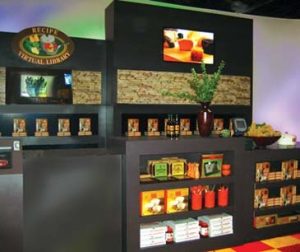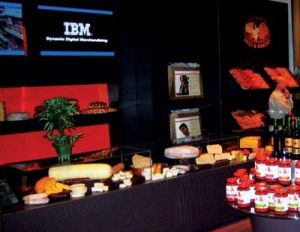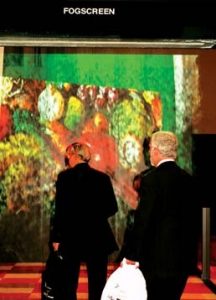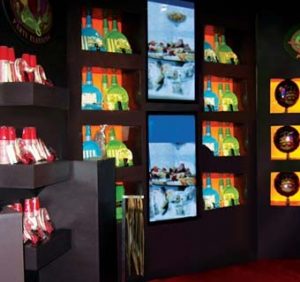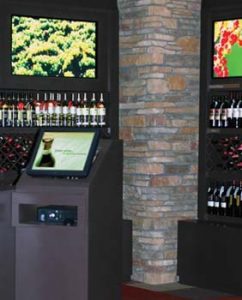For prehistoric humans, finding food was often a matter of eat or be eaten. In the future, might grocery shopping actually be more fun than that?
The X06 Marketplace, on display earlier this year at the National Retail Federation's annual convention and expo, was an experiment to show how new technology might fulfill that promise. That 8400-square-foot centerpiece was created by Richard Russo, president and creative director of Hybridia Design, a store design and retail imaging firm based in Clifton, Va. “This was a real-world Petri dish of design and technology developments,” Russo says, “all focused on the customer experience, information and services.”
This was Russo's second store of the future for NRF. A year earlier, he put together the X05, a 2000-square-foot bookstore concept demonstrating how technology could be used to enrich the shopping experience. (The X stands for “exploration.”)
Like its predecessor, the X06 includes technology supplied by a roster of high-tech heavyweights, including Cisco Systems, Digital Persuasion, FogScreen, IBM, IconNicholson, ID Merchandising, Intel, LG Electronics, MasterCard Paypass, Microsoft, Nanonation and Real Digital Media.
“Our focus in working with those vendors,” Russo explains, “was to create an environment that would not only more effectively sell groceries, but also go beyond that to play with the sensory parts of the shopping experience.”
That play on the senses began at the X06 entrance, where visitors passed through a ghost-like virtual projection screen from FogScreen (Helsinki, Finland). The screen, consisting of a wall of water and air, served as an intriguing portal to the X06 space. It also carried a series of promotional messages.
After passing through the FogScreen, visitors entered the X06's gourmet chef demo center, where chef/restaurateur/TV personality Mario Batali gave cooking demonstrations. Adjacent to the chef demo area was a recipe library, which featured TV screens showing excerpts from Batali's FoodTV programs. Real Digital Media (Sarasota, Fla.) provided the digital content management system for all screens. Microsoft (Redmond, Wash.) provided a kiosk where customers could access recipe information, or talk live with a subject matter expert (SME) via the Internet.
Most of the rest of the X06 space was devoted to six major shops – chocolate, deli/bakery/cheese, floral, wine, produce and party planning. High-tech touches in the X06's Coco Café included a stack of four 50-inch plasma screens from LG Electronics (Englewood Cliffs, N.J.) looping the “Truffle River,” a digitally created video showing chocolate truffles as if they were ripples of water in a real river and backdropping a merchandising unit holding exotic chocolate products. The Everywhere Display from IBM (Armonk, N.Y.) was comprised of three separate pedestals presenting three different chocolate products. When the shopper picked up one of three items on display, an overhead projector would flash information onto an adjoining white surface, providing customers with information or the chance to seek additional info or alternative recommendations (all by IBM).
The deli/bakery/cheese shop featured three 50-inch plasma screens displaying Dynamic Digital Marketing (DDM), promoting deli products such as cheeses and recommending the best wine matches. The floral department was equipped with an IBM Anyplace Kiosk, where customers could use a touchscreen to create and order a custom floral arrangement without a salesperson. It also reminded the customer about a loved one's approaching birthday.
A FogScreen at the wine shop entrance added an element of theatricality to the space, while also providing aesthetic imagery and promotional information on the vintages for sale. This zone also made use of RFID (radio frequency identification) technology from IconNicholson (New York). When a bottle is picked from the wine shelf, an RFID tag triggers three adjoining screens – the first provided detailed information on the wine, the second showed appropriate meals to accompany that wine and the third gave information on which wine glass to use, along with cross- and up-sell opportunities. What's more, if a shopper changes his or her mind and puts the wine down in another part of the store, employees can use the RFID system to track down the errant bottle's locale.
David Kepron, principal, retail design, at spg3 in Philadelphia (and a member of VM+SD's Editorial Advisory Board), said he was most impressed by the RFID system in the wine shop. “When you first lift a bottle from the shelf, a video monitor launched into an interactive sequence that tells you what you lifted up,” he says. “Well, I already knew that, since I did the lifting. But then the system offers you a number of delightful details about the wine you've chosen, and offers up suggestions for complementary foods – which are things I didn't know.”
But while the X06 project reinforced the great potential that technology has as an inventory-management tool for retailers, Kepron still isn't sure all the gizmos in the marketplace of the future added up to a better shopping experience.
“If you are interested in using technology to track product, manage inventory and automate replenishment and fulfillment processes, X06 represented a real windfall. But if you are interested in the customer experience, you might have felt like I did – intrigued by the possibilities, but tentative and somewhat skeptical about whether today's time-pressed customer will choose to embrace technology as a means-to-a-shopping-end.”
Hybridia's Russo knows that some retailers may have reservations initially about using all the X06's technologies in the front of the store. But he remains firm in his belief that such installations – when done right – can play a starring role in enhancing the shopping experience by using the same inventory-tracking technologies for these tailor-made customer experiences. He plans to continue making his case with the X07 display – whose exact nature and focus he's keeping under wraps for now.
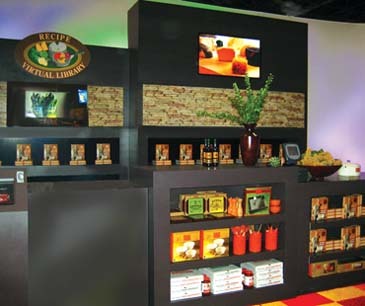

 Headlines2 weeks ago
Headlines2 weeks ago
 Headlines1 week ago
Headlines1 week ago
 Headlines2 weeks ago
Headlines2 weeks ago
 Headlines5 days ago
Headlines5 days ago
 Headlines1 week ago
Headlines1 week ago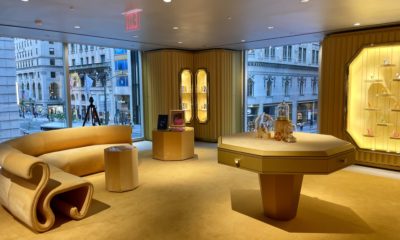
 Eric Feigenbaum3 days ago
Eric Feigenbaum3 days ago
 Designer Dozen1 week ago
Designer Dozen1 week ago
